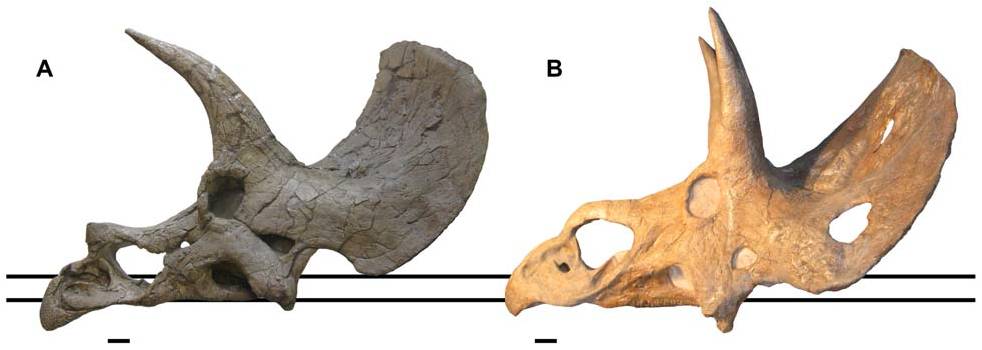Is Triceratops One or Three Species? Debate Continues

Triceratops, with its three large horns and great ruffled headdress, seems distinctive enough, but at one time paleontologists had named more than a dozen different species of the rhinoceros-like dinosaur.
These have been condensed into three recognized species in the Triceratops genus, but some researchers believe that number should be lower still: They suggest there is just one Triceratops, of whom the size and shape of its skull and head ornaments changed as it matured.
"It's important to understand how different dinosaurs grew," study researcher John Scannella, of Montana State University, told LiveScience in an email. "We are learning that many of them underwent considerable transformations throughout development, which leaves the potential for many different-looking growth stages that may be misinterpreted as many different-looking species of dinosaur."
The three species in question are: Triceratops, the classic three-horned, clown-ruffled dinosaur; Nedoceratops hatcheri, which the researchers suggest is an intermediate stage, but is only represented by a single fossil; and Torosaurus latus, which seems to be much larger than Triceratops and of which there are about a half dozen good-quality specimens. In the growth-stage scenario, Torosaurus would be the "old man" of the group.
Not everyone fully agrees with the remodeling, particularly Andrew Farke, a researcher from the Raymond M. Alf Museum of Paleontology in California. "I agree with them on many points… It's just the interpretation that I disagree with," he said, referring to the reserachers' conclusion that the different species are just different growth stages of the same species.
The "holy" trinity
One of the main differences among the three skulls is a set of large holes in the crown of Torosaurus. These holes are much smaller in Nedoceratops and in Triceratops they seem to be absent, though a close examination by Scanella showed evidence of the beginnings of these holes in some Triceratops.
Get the world’s most fascinating discoveries delivered straight to your inbox.
"By cutting up the frills of many Triceratops and examining thin slices under the microscope, it is possible to actually see how the skull changed shape throughout growth," Scannella wrote in an email to LiveScience. "We can actually see incipient holes developing in specimens with solid frills."
The researchers also explained other differences in shape between the skulls, including extra spikes around the edges of the crown in Torosaurus. The researchers believe that these bony protrusions on Triceratops split in two later in life, as the animal matured, appearing more like Torosaurus.
This hasn't been seen in other dinosaurs with similar morphologies, Farke said. "Looking at the growth cycle of other horned dinosaurs, there's no evidence that this number changes as they grow," he said. "The scales don't double in number, they just get bigger."
Tri-Triceratops
Supporting this theory is the lack of juvenile Torosaurus specimens, some researchers say. The fossils discovered seem to fit a normal population curve: few young, few old, but many middle-age animals, as one would expect if you were to take a cross section of a living population, said Robert Sullivan, a researcher from the State Museum of Pennsylvania, who wasn't involved in the study.
Spencer Lucas, another researcher who wasn't involved in the study, from the New Mexico Museum of Natural History and Science, said more samples are needed to prove that these skulls all come from the same species, especially for the less-represented fossils.
"[Scanella] may be right and it is a good idea. It's forcing people to really look at the variation and the differences in anatomy in the different dinosaur fossils," Lucas said. "But he still lacks the silver bullet." A group of samples from the same "bone bed" containing individuals of all different ages would do the trick, Lucas said.
Most of these Triceratops, Torosaurus and Nedoceratops fossils do come from the same area (the Northwestern United States) and the same time frame — one that covers only about 2-million-to-3-million years — according to Sullivan.
"It's a really important study, I really think they are on to something, I still have a little problem accepting that Torosaurusis separate, but that's my own point of view," Sullivan said. "I'm more inclined to agree with them that Torosaurus is probably an old-age Triceratops. A lot of people don't want to give up a notion of a separate animal, though."
The study was published Wednesday (Dec. 14) in the journal PLoS ONE.
You can follow LiveScience staff writer Jennifer Welsh on Twitter @microbelover. Follow LiveScience for the latest in science news and discoveries on Twitter @livescience and on Facebook.
Jennifer Welsh is a Connecticut-based science writer and editor and a regular contributor to Live Science. She also has several years of bench work in cancer research and anti-viral drug discovery under her belt. She has previously written for Science News, VerywellHealth, The Scientist, Discover Magazine, WIRED Science, and Business Insider.




